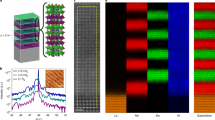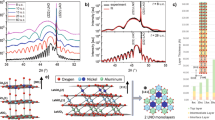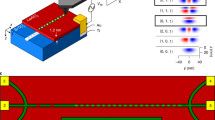Abstract
In an effort to scale down electronic devices to atomic dimensions1, the use of transition-metal oxides may provide advantages over conventional semiconductors. Their high carrier densities and short electronic length scales are desirable for miniaturization2, while strong interactions that mediate exotic phase diagrams3 open new avenues for engineering emergent properties4,5. Nevertheless, understanding how their correlated electronic states can be manipulated at the nanoscale remains challenging. Here, we use angle-resolved photoemission spectroscopy to uncover an abrupt destruction of Fermi liquid-like quasiparticles in the correlated metal LaNiO3 when confined to a critical film thickness of two unit cells. This is accompanied by the onset of an insulating phase as measured by electrical transport. We show how this is driven by an instability to an incipient order of the underlying quantum many-body system, demonstrating the power of artificial confinement to harness control over competing phases in complex oxides with atomic-scale precision.
This is a preview of subscription content, access via your institution
Access options
Subscribe to this journal
Receive 12 print issues and online access
$259.00 per year
only $21.58 per issue
Buy this article
- Purchase on Springer Link
- Instant access to full article PDF
Prices may be subject to local taxes which are calculated during checkout




Similar content being viewed by others
References
Britnell, L. et al. Field-effect tunneling transistor based on vertical graphene heterostructures. Science 335, 947–950 (2012).
Takagi, H. & Hwang, H. Y. An emergent change of phase for electronics. Science 327, 1601–1602 (2010).
Dagotto, E. Complexity in strongly correlated electronic systems. Science 309, 257–262 (2005).
Hwang, H. Y. et al. Emergent phenomena at oxide interfaces. Nature Mater. 11, 103–113 (2012).
Boris, A. V. et al. Dimensionality control of electronic phase transitions in nickel-oxide superlattices. Science 332, 937–940 (2011).
Eguchi, R. et al. Fermi surfaces, electron–hole asymmetry, and correlation kink in a three-dimensional Fermi liquid LaNiO3 . Phys. Rev. B 79, 115122 (2009).
Chakhalian, J. et al. Asymmetric orbital–lattice interactions in ultrathin correlated oxide films. Phys. Rev. Lett. 107, 116805 (2011).
Qazilbash, M. M. et al. Electronic correlations in the iron pnictides. Nature Phys. 5, 647–650 (2009).
Rajeev, K., Shivashankar, G. & Raychaudhuri, A. Low-temperature electronic properties of a normal conducting perovskite oxide LaNiO3 . Solid State Commun. 79, 591–595 (1991).
Xu, X. Q., Peng, J. L., Li, Z. Y., Ju, H. L. & Greene, R. L. Resisitivity, thermopower, and susceptibility of RNiO3 (R = La,Pr). Phys. Rev. B 48, 1112–1118 (1993).
Sreedhar, K. et al. Electronic properties of the metallic perovskite LaNiO3: correlated behavior of 3d electrons. Phys. Rev. B 46, 6382–6386 (1992).
Ouellette, D. G. et al. Optical conductivity of LaNiO3: coherent transport and correlation driven mass enhancement. Phys. Rev. B 82, 165112 (2010).
Stewart, M. K. et al. Optical study of strained ultrathin films of strongly correlated LaNiO3 . Phys. Rev. B 83, 075125 (2011).
Deng, X. et al. Hallmark of strong electronic correlations in LaNiO3: photoemission kink and broadening of fully occupied bands. Phys. Rev. B 85, 125137 (2012).
Meevasana, W. et al. Hierarchy of multiple many-body interaction scales in high-temperature superconductors. Phys. Rev. B 75, 174506 (2007).
Scherwitzl, R. et al. Metal–insulator transition in ultrathin LaNiO3 Films. Phys. Rev. Lett. 106, 246403 (2011).
Son, J. et al. Low-dimensional Mott material: transport in ultrathin epitaxial LaNiO3 films. Appl. Phys. Lett. 96, 062114 (2010).
Gray, A. X. et al. Insulating state of ultrathin epitaxial LaNiO3 thin films detected by hard X-ray photoemission. Phys. Rev. B 84, 075104 (2011).
Sakai, E. et al. Gradual localization of Ni 3d states in LaNiO3 ultrathin films induced by dimensional crossover. Phys. Rev. B 87, 075132 (2013).
Lacorre, P. et al. Synthesis, crystal structure, and properties of metallic PrNiO3: comparison with metallic NdNiO3 and semiconducting SmNiO3 . J. Solid State Chem. 91, 225–237 (1991).
Horiba, K. et al. Electronic structure of LaNiO3: an in situ soft X-ray photoemission and absorption study. Phys. Rev. B 76, 155104 (2007).
Yoshimatsu, K. et al. Metallic quantum well states in artificial structures of strongly correlated oxide. Science 333, 319–322 (2011).
Meevasana, W. et al. Creation and control of a two-dimensional electron liquid at the bare SrTiO3 surface. Nature Mater. 10, 114–118 (2011).
Ioffe, A. F. & Regel, A. R. Non-crystalline, amorphous, and liquid electronic semiconductors. Prog. Semicond. 4, 237–291 (1960).
Valla, T. et al. Coherence–incoherence and dimensional crossover in layered strongly correlated metals. Nature 417, 627–630 (2002).
Frano, A. et al. Orbital control of noncollinear magnetic order in nickel oxide heterostructures. Phys. Rev. Lett. 111, 106804 (2013).
Schwier, E. F. et al. Unusual temperature dependence of the spectral weight near the Fermi level of NdNiO3 thin films. Phys. Rev. B 86, 195147 (2012).
Uchida, M. et al. Pseudogap of metallic layered nickelate R2–xSrxNiO4 (R = Nd,Eu) crystals measured using angle-resolved photoemission spectroscopy. Phys. Rev. Lett. 106, 027001 (2011).
Lau, B. & Millis, A. J. Theory of the magnetic and metal-insulator transitions in rNiO3 bulk and layered structures. Phys. Rev. Lett. 110, 126404 (2013).
Hwang, J. et al. Structural origins of the properties of rare earth nickelate superlattices. Phys. Rev. B 87, 060101 (2013).
Chen, H. et al. Modifying the electronic orbitals of nickelate heterostructures via structural distortions. Phys. Rev. Lett. 110, 186402 (2013).
Torrance, J. B., Lacorre, P., Nazzal, A. I., Ansaldo, E. J. & Niedermayer, C. Systematic study of insulator–metal transitions in perovskites RNiO3 (R = Pr,Nd,Sm,Eu) due to closing of charge-transfer gap. Phys. Rev. B 45, 8209–8212 (1992).
Evtushinsky, D. V. et al. Bridging charge–orbital ordering and Fermi surface instabilities in half-doped single-layered manganite La0.5Sr1.5MnO4 . Phys. Rev. Lett. 105, 147201 (2010).
Acknowledgements
This work was supported by the Office of Naval Research (grant no. N00014-12-1-0791), the National Science Foundation (NSF) through the MRSEC programme (Cornell Center for Materials Research, DMR-1120296) and was performed in part at the Cornell NanoScale Facility, a member of the National Nanotechnology Infrastructure Network, which is supported by the National Science Foundation (grant ECCS-0335765). X. He and I. Božović were supported by the US Department of Energy, Basic Energy Sciences, Materials Sciences and Engineering Division. H.I. Wei acknowledges support from the NSF IGERT programme (DGE-0654193). The authors thank A. Georges, C.A. Marianetti, A.J. Millis, J.A. Mundy, T.W. Noh, and C.J. Palmstrøm for discussions.
Author information
Authors and Affiliations
Contributions
The samples were grown by P.D.C.K. and C.A. and characterized by P.D.C.K., H.I.W. and Y.F.N. ARPES measurements were performed by P.D.C.K., H.I.W., Y.F.N. and M.U. and analysed by P.D.C.K. S.Z. grew the LaAlO3 buffer layers used for some samples. X.H. and I.B. performed the high-pressure oxygen annealing experiments and corresponding sample characterization. P.D.C.K. and K.M.S. wrote the paper, with input and discussion from all co-authors. P.D.C.K., D.G.S. and K.M.S. devised the project and were responsible for its overall planning and direction.
Corresponding author
Ethics declarations
Competing interests
The authors declare no competing financial interests.
Supplementary information
Supplementary information
Supplementary Information (PDF 5659 kb)
Rights and permissions
About this article
Cite this article
King, P., Wei, H., Nie, Y. et al. Atomic-scale control of competing electronic phases in ultrathin LaNiO3. Nature Nanotech 9, 443–447 (2014). https://doi.org/10.1038/nnano.2014.59
Received:
Accepted:
Published:
Issue Date:
DOI: https://doi.org/10.1038/nnano.2014.59
This article is cited by
-
Tuning orbital-selective phase transitions in a two-dimensional Hund’s correlated system
Nature Communications (2023)
-
Nd:YAG infrared laser as a viable alternative to excimer laser: YBCO case study
Scientific Reports (2023)
-
Quantization condition of strongly correlated electrons in oxide nanostructures
Communications Materials (2023)
-
Atomic scale interfacial magnetism and origin of metal-insulator transition in (LaNiO\(_3\))\(_n\)/(CaMnO\(_3\))\(_m\) superlattices: a first principles study
Scientific Reports (2023)
-
Atomic and electronic structures of correlated SrRuO3/SrTiO3 superlattices
Journal of the Korean Physical Society (2023)



